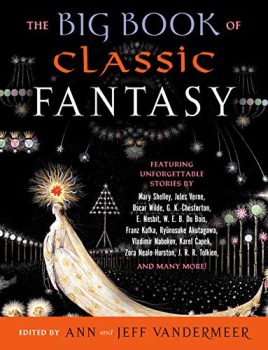A to Z Reviews: “The Hump,” by Fernan Caballero
Fernán Caballero was the pen name of Cecilia Francisca Josefa Böhl de Faber y Ruiz de Larrea (1796–1877). In 1811, she published the short fable “The Hump,” which is a take on the fairy tale trope of a king promising to give half his kingdom away to anyone who would marry his stubborn daughter.
What struck me in reading this story is the oddity of the trope. Sure, monarchs would marry their children (or themselves) off to make alliances with other monarchs, but part of this trope is that it is so random. Marrying the princess off to whoever could slay a dragon or whatever may demonstrate that the individual is skilled in combat, but it doesn’t necessarily equate to the skills to rule a kingdom.
In “The Hump,” the king determines to marry his daughter off to whomever can say what materials she used to have a tambourine made. Even less of an indicator of ability to rule a kingdom, although perhaps useful if the king is more interested in marrying his daughter off to a musician.
This type of story is often a fable, providing a moral about behavior, however in this particular case, the princess’s behavior isn’t punished in the long run, instead resulting in a happily ever after. Not for all the characters, but certainly the princess.

Cover by Joe Montgomery
In this story, the princess was on her way to Mass when she was accosted by a beggar. She brushed him off and he flicked a flea at her. The princess took the flea and fattened it up, eventually having its skin turned into the tambourine in question. Princes, kings, and commoners failed to identify the material until the princess spotted a prince and fell in love with him. She tried to tell him what the tambourine was made of, but he failed to hear her. The beggar did, though, and used the knowledge to win her hand.
Had the story stopped there, Caballero would have provided a moral to her fable that was in keeping with tradition. However, half the story remained to be told.
After being exiled by her father (who cleverly only promised marriage, not half his kingdom), with her beggar husband, the princess managed to rid herself of him, but at the expense of gaining his hump (it is a fable, laws of physics and logic need not apply, accept things as they are). The hump mimics her speech, so she pretends to be a mute.
Upon finding the lands where the prince she fell in love (or at least lust) with, she gets hired as a mute, hunchbacked maid (but she’s happy just to be near him). He, however, needs to be married off to a suitable princess, which she no longer is. However, everything ends happily ever after for the princess and the prince, although, in a clever aside that really nails the story, not for the narrator.
Caballero is aware of the traditions with which she is playing and clearly savors turning them upside down. She also is happy to break the fourth wall at the very end, reaching out directly to the audience in a manner that makes this a clever and appealing story.
The version I read appeared in The Big Book of Classic Fantasy, edited by Ann and Jeff VanderMeer and translated into English from Spanish by Marian and James Womack.
 Steven H Silver is a twenty-time Hugo Award nominee and was the publisher of the Hugo-nominated fanzine Argentus as well as the editor and publisher of ISFiC Press for eight years. He has also edited books for DAW, NESFA Press, and ZNB. His most recent anthology is Alternate Peace and his novel After Hastings was published in 2020. Steven has chaired the first Midwest Construction, Windycon three times, and the SFWA Nebula Conference six times. He was programming chair for Chicon 2000 and Vice Chair of Chicon 7.
Steven H Silver is a twenty-time Hugo Award nominee and was the publisher of the Hugo-nominated fanzine Argentus as well as the editor and publisher of ISFiC Press for eight years. He has also edited books for DAW, NESFA Press, and ZNB. His most recent anthology is Alternate Peace and his novel After Hastings was published in 2020. Steven has chaired the first Midwest Construction, Windycon three times, and the SFWA Nebula Conference six times. He was programming chair for Chicon 2000 and Vice Chair of Chicon 7.

This one sounds very interesting… some of the less sensical elements recall the frame story for “Tales from the Pentamerone” to me, given odd consequences and zigs in narrative. Thank you for the description and review. Will definitely be checking it out if I can lay my hands on a copy.
Not sure if it makes any difference, but since you questioned the validity of killing a dragon as a measure of ruling ability, I wanted to share a few things I’ve heard in the course of that exact discussion over the years that might shed a dim light on the tradition:
Western Literature:
In both pagan and Christian traditions, dragons have been associated with evil or danger on the regular. See:
–The wyrm chewing on the roots of Yggdrasil.
–The dragon of Beowulf.
–Poetry and prose from Europe and into Eurasia reviling the prows of longboars.
–The dragon of the Book of Revelation.
So, until recently, the dragon was used to represent powerful evil (explaining why many tend to eat or otherwise claim maidens; evil seeks to devour purity or corrupt it). This was in spite of whether the fairytale comes from pre- or post-Christian Diaspora. A person who kills a dragon is therefore someone who not only has great combat prowess, but also shows commitment to good against evil, and also will risk a personal all to try to preserve the kingdom from danger. Some guy who can fight, who is committed to steering the kingdom in the path of righteousness, and who is willing to offer himself up as a sacrifice (especially if he made sure his page/squire/loyal follower representing the peasantry stayed somewhere safe) to make life good for everyone? Pretty good leadership candidate.
Eastern Literature:
The killing of dragons occurs much less often. In fact, personally I can’t think of a single time it does happen, but one or two have been named in my hearing before. However, that has a lot to do with the general connection of the dragon with the current leader’s power and luck. (See: the Nine-Dragon Screen in China.) Emperors are often represented by or named for dragons. A powerful dragon can be seen as an indication that a mythological or legendary leader holds the Mandate of Heaven to rule.
The few times that some person kills off a dragon in Eastern stories, I’m told that it is always the former leader’s dragon that dies (whether to a human, or to the succeeding leader’s dragon). The fact of that dragon’s death is an indication that that leader either never had or no longer has the Mandate of Heaven. The person who killed the dragon or the person who is represented by the person or dragon who killed a dragon now has the Mandate of Heaven.
Pointed to by divine powers as the next blessed leader? Pretty good leadership candidate.
Not sure that makes any difference.